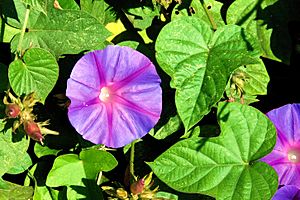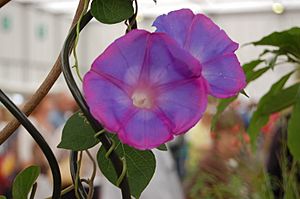Ipomoea indica facts for kids
Quick facts for kids Ipomoea indica |
|
|---|---|
 |
|
| Blue morning glory | |
| Scientific classification | |
| Genus: |
Ipomoea
|
| Species: |
indica
|
| Synonyms | |
Ipomoea indica is a type of flowering plant in the plant family called Convolvulaceae. It has many common names, like blue morning glory, oceanblue morning glory, koali awa, and blue dawn flower. This plant has leaves that look like hearts or have three lobes. Its flowers are shaped like funnels and are purple or blue. They are about 6 to 8 centimeters (2.4 to 3.1 inches) wide. These flowers bloom from spring to autumn. Each flower has both male and female parts. This plant has won an award called the Royal Horticultural Society's Award of Garden Merit.
People often grow this plant because its flowers are very pretty. However, it can grow too much and take over in many parts of the world. In New Zealand, it is even listed as an unwanted plant under the Biosecurity Act 1993.
Contents
Plant Names and Their Meanings
The second part of the plant's scientific name, indica, means "from India," or "from the East Indies or China." But for I. indica, the name probably refers to the West Indies. This is because the plant originally comes from the New World, which includes North and South America.
What the Plant Looks Like
Ipomoea indica is a strong, long-living plant. It is a perennial vine, meaning it lives for many years. It is originally from warm places around the world, like tropical and subtropical areas. You can often find it in forests that have been disturbed, at the edges of forests, in suburban areas, and along roadsides and rivers.
This plant is a great climber. It can climb over other plants, walls, and hillsides. Its climbing habit helps it compete well with trees and shrubs. It is a twisting plant that can sometimes lie on the ground. Its stems can grow from 3 to 6 meters (10 to 20 feet) long. Sometimes, roots can grow from the stem where it touches the ground.
The leaves have stalks called petioles that are 2 to 18 centimeters (0.8 to 7.1 inches) long. The leaf itself is shaped like an egg or is round. It is 5 to 15 centimeters (2 to 6 inches) long and 3.5 to 14 centimeters (1.4 to 5.5 inches) wide. The underside of the leaf has many tiny hairs, while the top has fewer hairs. The bottom of the leaf is heart-shaped, and its edges can be smooth or have three lobes. The tip of the leaf is pointed.
The flower is shaped like a funnel. It is 5 to 8 centimeters (2 to 3 inches) long and is smooth, without hairs. It is bright blue or bluish-purple. As the flower gets older, it can turn reddish-purple or red. The center of the flower is usually a bit lighter in color.
I. indica is a long-lived plant. It can live for up to 25 years!
Flowers and Fruits
The flowers grow in dense clusters. The stems that hold these flower clusters are 4 to 20 centimeters (1.6 to 7.9 inches) long. There are small, thin leaves called bracts near the flowers. The flower stems themselves are short, only 2 to 5 millimeters (0.08 to 0.2 inches) long.
The sepals are leaf-like parts that protect the flower bud. They are about 1.4 to 2.2 centimeters (0.55 to 0.87 inches) long and are mostly hairless. The stamens (male parts) and the pistil (female part) do not stick out beyond the flower. The ovary (where seeds form) is hairless. The top part of the pistil, called the stigma, has three lobes.
The fruits are round capsules, about 1 to 1.3 centimeters (0.4 to 0.5 inches) wide. The seeds inside are about 5 millimeters (0.2 inches) in size. These seeds can be spread by rain, wind, people, gravity, and water.
When the plant flowers and produces fruit depends on where it is growing. In some countries, like Costa Rica and Nicaragua, it flowers and fruits all year round. In other places, like South Africa, it only flowers and fruits during certain months.
Where the Plant is Found
It's not completely clear where Ipomoea indica first came from. This is because people have planted it all over the world in warm areas. Most experts now think it originally came from the Neotropics. This area stretches from Florida in the United States down to Mexico, Central America, the Caribbean, and South America.
It is also thought to be native to some Pacific islands. These include Palau, the Hawaiian Islands (where it's called Koali ‘awa), French Polynesia, and Micronesia. However, some experts believe it was brought to the United States, Mexico, and parts of its Caribbean and Pacific range by people. They see it as a plant that has been introduced and has spread too much.
An Invasive Plant
Ipomoea indica has become a harmful invasive plant in many places. These include Australia, California, China, Ethiopia, France, Greece, Italy, Kenya, Mexico, Montenegro, New Caledonia, New Zealand, Portugal, South Africa, Tanzania, and Uganda.
In New Zealand, it is called an "unwanted organism" under the Biosecurity Act 1993. This means it is against the law to sell, grow, or spread the plant there. It is also on the National Pest Plant Accord list for New Zealand.
When this plant grows in good conditions, it can spread very quickly. It spreads through its seeds, creeping stems called stolons, and even small pieces of its stem. I. indica can make a huge number of seeds, which are easy to grow. This helps the plant quickly take over new areas.
It can grow over existing trees, shrubs, and other plants. Blue morning glory is very good at competing with native plants for space, food, sunlight, and water. Its creeping stems can form a thick mat over plants on the ground. This blocks the sunlight these plants need to grow. The stems can also grow very fast, helping the plant spread even more. If a piece of the plant breaks off during removal, it can grow into a new plant.
There is only one known natural enemy of I. indica. It is a type of plant disease called Albugo ipomoeae-panduratae. This disease has been seen infecting the plant. Because it has so few natural enemies, I. indica is very successful at invading new places.
How People Grow It
Blue morning glory is a popular plant grown for its colorful flowers. It has spread across warm and hot regions of the Old World (Europe, Asia, Africa), even though it didn't originally come from there.
This plant does not like cold temperatures. If the temperature drops below 7 degrees Celsius (45 degrees Fahrenheit), it won't survive. So, in cooler areas, people grow it indoors in greenhouses. It likes soil that is very light and full of nutrients. The soil should also be kept moist all the time.
Images for kids
-
Purple flowers in Uruguay
See also
 In Spanish: Ipomoea indica para niños
In Spanish: Ipomoea indica para niños





